
Venereal Disease Treatment Menu: 1 2 3 4 5 6 7 8 9 10 11 12 13 14 Next>>
Venereal Diseases in the Golden Age of Piracy, Page 4
VD Medicines
The number of medicines recommended for use in treating venereal diseases were wide and varied. Each medical professional who wrote about venereal diseases during the golden age of piracy seemed to have their own idea about what would be effective. In addition, different medicines were recommended for
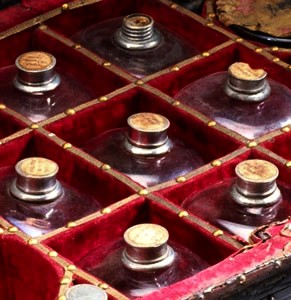
Medicine Bottles in 16th Century Geonese Medicine Chest
different symptoms, resulting in a list of hundreds of ingredients being suggested by the various medical authors at this time.
Such ingredients were combined and used in different ways, many of which are specific to the symptom and doctor. Sea surgeon John Atkins believed this to be the only way a competent surgeon could administer medicines to patients with venereal illnesses, explaining that "No Nostrum as yet, how infallible soever in the Opinion of its Possessor, will answer to all Symptoms, or to all Patients under the same Circumstances"1. The idea that the medicine required to heal an illness depended on a variety of factors was not uncommon during this period. Atkins goes on to explain that "the Art of Curing here, as in other Diseases, lies as much in the Management as in the Medicines themselves, that they be administred in Season, and adapted to Constitutions; so that ...the Skill of using it [a medicine]... will never be attained in any great Perfection without Practise."2
However, there were certain types of medicines which were commonly suggested for venereal diseases which are discussed here. The medicine classifications used in this section come primarily from the 1713 book The Symptoms, Nature, Cause and Cure of a Gonorrhoea written by naval physician William Cockburn. Although this suggests remedies which are only to be used in gonorrhea, he believed that gonorrhea was the middle stage of the progression from infection to syphilis, like most medical men during this period.
Curiously, when discussing each category of medicine, Cockburn is generally critical of each of those discussed in other physicians' books. For example, in his overview of the topic, he explains that purging medicines
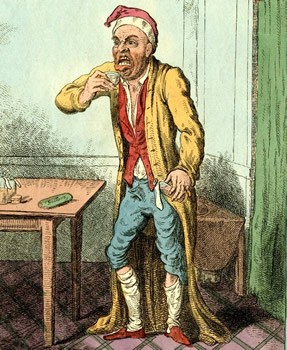
Image: Isaac Cruikshank - Taking Physic (1801)
have, most commonly, failed the Expectations these Practitioners did not not doubt to reap from them: after using them in different Forms of: Pill, Potions, Ptisans [sweetened medical concoctions], &c. have had recourse to Restringing [astringent or cleansing medicines], some to balsamical or healing Medicines; and not a few to such as excite a Quantity of Urine; and the rest have combined all these Means together. Thus we have Purging without Design, Healing without any particular View, and Jumble of Medicines taken up without Reason; administred without Judgment.3
When Cockburn moves on to examine each medicine class individually, he usually starts by pointing out why that class should not be useful in treating venereal diseases, frequently going on to provide detailed recipes for a variety of them. He then suggests that they may still be used or that there is no better option, sometimes providing even more recipes for such medicines which he claims are the most useful.
Modern naval physician and historian John Keevil notes that Cockburn was "a sycophant who did not even trouble to make [his medical theories] consistent or to reconcile them with the evidence. ...Cockburn was content to neglect all investigation and experiment provided his opinions were acceptable and enhanced his reputation for learning. He was less concerned for their practical outcome"4. This may help explain the reason he dismisses and then embraces so many types of medicines in his book.
Whatever his biases, most of the sea surgeons discuss medicines which can be fit into Cockburn's categories. These include medicines which were purging (causing vomiting), diuretic, astringents (flesh drawing), balsamic (healing), sudorific/diaphoretic (sweat-inducing). A sixth type of medicine which Cockburn does not specifically address is also discussed because of its importance to the problem: mercury-based medicines. These were primarily used to cause salivation. Each of these types of medicines are examined in this section in some detail, focusing on the medicines more than the specific venereal cures. (Those will be discussed later in this article.) Note that the medical men felt that most medicines had more than one operative property resulting in the same medicine sometimes being found in more than one category. Let's look at these six classes of medicines and their use in treating venereal diseases.
1,2 John Atkins, “The Preface”, Lues Venerea, not dated and not paginated; 3 William Cockburn, The Symptoms, Nature, Cause and Cure of a Gonorrhoea, 1713, p. 100; 4 John J. Keevil, Medicine and the Navy 1200-1900: Volume II – 1640-1714, 1958, p. 25;
VD Medicines: Purges
Purging medicines were primarily used when treating the gonorrhea 'stage' of a venereal disease. Sea physician William Cockburn explains that purges function by "Emptying the Guts, or their rendering the Blood, and other Liquors, Thicker, or Thinner;
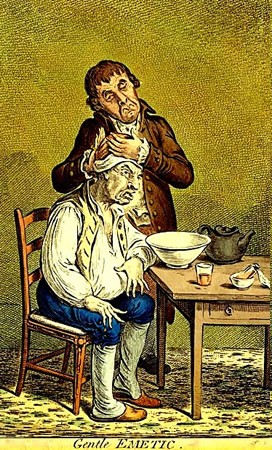
Artist: James Gillray
A Physicians Administering an Emetic Purge (1804)
according to the Quantity of Evacuation made from the Blood, in Men of different Constitutions."1 He goes on to say that they do nothing to destroy the venereal 'poison', they just help remove some of it. Sea surgeon John Moyle explained that the gonorrhea 'stage' of venereal disease "requires good Purging, with Medicines proper and specifick to it. For no man is [able] to give things to stop it, any otherwise then by fair purging"2.
Fellow sea surgeon John Atkins gives only faint praise to purges in treating gonorrhea, and then only when used to eliminate mercury from the body after it has been administered as part of the cure. He explains that purges are administered, "not so much from a Supposition that their Vertues immediately reach the Part affected, and subdue the Poison [mercury] directly, as from a distant View of altering the Habit of Body, and carrying off those vicious Humours that would else probably take their Course that way, and heighten the Fury: This Opinion is founded in Practice"3. He goes on to explain that their purpose is to prevent the mercury from remaining in the body too long.
Atkins then sort of waffles, noting that nature will eventually eliminate the mercury by herself, making purges a gilt-edged sword. Problems are caused both by "leaving them off too soon, or continuing them too long"4. He also warns that if any medicines including cathartics (purges) are given at the wrong time, the gonorrhea "at last brings an irrecoverable Laxity on the Parts, converting a Venereal to a troublesom Seminal Gleet [referring to the urethral discharge of what he perceived to be semen]."5
Cockburn starts out saying he is against the practice, explaining that purging medicines do not "contribute to destroy the Sharpness of Gonorrhœa;
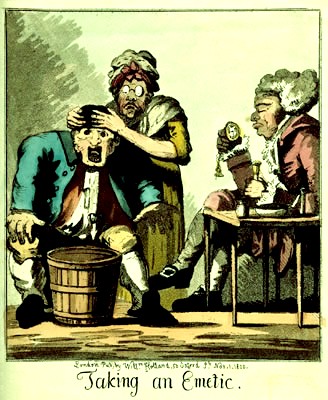
Image: G.M. Woodward - Taking an Emetic (1800)
and many of them are known to increase it."6 He notes that "when the Blood is weakned by the Purging Medicines, the Tenseness of Fibres is likewise weakned, and the Running [discharge from the urethra] is in a greater Quantity"7 and "it is evident that Purging Medicines do
not act directly in the Cure of a Gonorrhœa. …the stimulating [of the urethral flow] is often so great by Purging Medicines; that I am ready to think a Gonorrhœa may be, more speedily, Cured, without taking any Medicines"8. Nevertheless, he goes on to detail the preparation of ten different purges, explaining that he does so because "Purging Medicines have been proved, to be of some Use in the Cure of a Gonorrhœa; as is likewise manifest by Experience"9.
So while Moyle is alone among the sea surgeons under study in boldly recommending the use of purges to treat gonorrhea, the other surgeons and physicians only grudgingly admit that, although it makes no theoretical sense, they work in practice.
German military surgeon Matthias Gottfried Purmann argues that the urethral discharge caused by gonorrhea is how the body intentionally infects itself in an effort to eliminate the venereal taint. As a result, physicians who give purging medicines "cross the designs of Nature in throwing off the Putredinous Venereal Matter, till at length it is forced to Stop of itself, and then it gradually infects the whole Body, which is certainly a Strange way of Curing"10. However, even he leaves the door open to limited purging. "I will not oppose their Purging if the Inflammation [causing the urethral discharge] is very violent"11, still adding that purging is in no way a cure-all and that it typically does more harm than good.
A variety of simple medicines in the sea surgeon's dispensatory article were suggested to have purging properties. Some of these were used to create medicines recommended for treating venereal diseases. Some of the purging simples mentioned by the authors under study include Agaricum, Amygdalarum Dulcium (Sweet Almonds), Argentum Vivum (Mercury), Cassia fistula, Guaiacum Officinale & Cortex Guaiacum (Guaiacum Bark), Pulvis Scammonium, Radix Jalapium (Jalap Root), Radix Rhabarbarum (Rhubarb Root) & Rhubarb, Stibium (Antimony), and Turbith. Cockburn also notes that "Mercurial Medicines are very frequently mix'd in with Cassia; both on the Account of its being a soft and easy Purgative; as also, that it is thought particularly Useful to the Bladder, and Urethra."12
1 William Cockburn, The Symptoms, Nature, Cause and Cure of a Gonorrhoea, 1713, p. 103; 2 John Moyle, Chirugius Marinus: Or, The Sea Chirurgeon, 1693, p. 139; 3 John Atkins, The Navy Surgeon, 1742, p. 25-6; 4 Atkins, p. 26; 5 Atkins, p. 28; 6 Cockburn, p. 102; 7 Cockburn, p. 104; 8 Cockburn, p. 104-5; 9 Cockburn, p. 106; 10,11 Matthias Gottfried Purmann, Churgia Curiosa, 1706, p. 340; 12 Cockburn, p. 108
VD Medicines: Diuretics
Diuretics are medicines given to increase urination. Like purging medicines, they are primarily used in treating the gonorrhea 'phase' of venereal diseases. However, they were only of limited use by the authors under study when treating venereal diseases. Naval physician William Cockburn explains that the reason to increase urine flow "is to wash the Parts [over which it flows]; it is very manifest, that the Use of
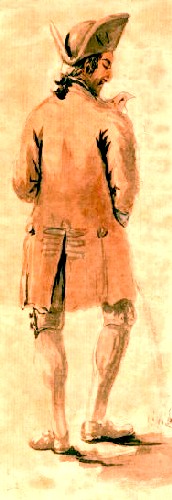
Artist: Gabriel Bray
Man Urinating on the Way to
Portsmouth (c. 1774-5)
Diuretical Medicines is not any other, than mere Washing without any regard to the Gonorrhœa."1
Sea surgeon John Atkins suggests another reason for using diuretics: relieving the pain of urination, a symptom of gonorrhea. He explains that they "are suppos'd to ease the Heat of Water [burning urination] by increasing the Quantity, and so diluting the Salts; so, to this end such an Injection may be serviceable also as is soft, and can leave something of a Mucilaginous Substance to lubricate and defend the Urethra."2 According to Atkins, in order to be most effective, soothing and sticky diuretics are injected into the urethra both to protect it and make the offending salts in the urine less irritating. This is apparently based on the Paracelsian notion that the body (as well as everything else) was made of three elements: sulfur, salt and mercury. Like bodily humors, while they were useful when kept in proper balance, an excess of any one of them resulted in pain and/or illness.
However, both Cockburn and Atkins raise objections to the use of diuretics in treating venereal diseases. Just as he had said about purges, Atkins warned that both over- and under-use of "irritating Medicines" such as diuretics would fail to stop the urethral discharge associated with the gonorrhoea.3
In typical fashion, Cockburn starts by explaining why diuretic medicines can't possibly work. He states that "no Parts, except the Urethra, can be wash’d to any purpose, by this extraordinary Quantity of Urine... It is for this Reason, that Diuretical Medicines are found to be of no Use, in Curing a Gonorrhoea in Women; the seat of it, in them, being much higher in the Vagina, than it can be washed with their Urine."4 He goes on to provide a detailed and confusing explanation of why urine will ultimately fail to wash the prostate, his candidate for the origin of gonorrheal poison, finishing by noting that the prostate "cannot have any Benefit from the Water."5 He then says, "By consequence, Diuretical Medicines could not be of any Use, in curing a Gonorrhœa; which contradicts our daily Experience."6 He adds that given "the Inconveniences that attend a Long use of Diuretical Medicines... we would not use them, to the greater Detriment of People; if other Methods could be found out. But it is sufficient to name them, this Place not being the most proper for such Inquiries."7 This is followed by a list of nine compound diuretic medicine prescriptions. Cockburn must once again have it both ways, lightly dancing around any need to test his statements.
Cockburn does suggest that some diuretic medicines are better than others. The best are those "which, not only, excite a greater Quantity of Water, but also stimulate the
Photo: Wiki User ChamicalInterest - Cream of Tartar (Potassium Hydrogen Tartrate)
Parts they pass over: And these have been thought, to be more effectual in stop[p]ing a Gonorrhœa, and changing its Colour"8. The 'colour' he is referring to has to do with the tint of the urethral discharge of pus which ranged from green to yellow to white. He refers to this as 'The Modern Method', listing scripts for two medicines, both of which contain Electuarium Rhubarb, Cantharides (Spanish Fly Wings), Gummi Guaici (Guaiacum Resin), Balsamum Pervianum (Balsam of Peru) and cochineal bugs in various quantities.
Several diuretics included in the Sea Surgeon's Dispensatory are also found in Cockburn's and Atkins' prescriptions for treating gonorrhea. These include: Amygdalarum Dulcium (Sweet Almonds), Baceæ Juniperi (Juniper Berries), Cremor Tartari (Cream of Tartar), Hordeum (Barley), Sal Absinthii (Salt of Wormwood), Semen Cari (Caraway Seed), Semen Chichoreum (Chicory/Succory Seed), Semen Citrulli (Citrullus Seed), Semen Lactucæ (Lettuce Seed) & Terebinthina Common (Turpentine).9
1 William Cockburn, The Symptoms, Nature, Cause and Cure of a Gonorrhoea, 1713, p. 124; 2 John Atkins, Lues Venerea, not dated, p. 27; 3 Atkins, p. 28-9; 4 Cockburn, p. 125; 5,6 Cockburn, p. 126; 7 Cockburn, p. 126-7; 8 Cockburn, p. 129; 9 See Atkins, p. 27 & Cockburn, p. 127-9
VD Medicines: Astringents
Astringents (sometimes also called restringents) are medicines which draw bodily tissues together, restricting the flow of liquids from them.
Like purging and diuretic medicines, astringents were sometimes used in treating the fluid discharge caused by gonorrhea.
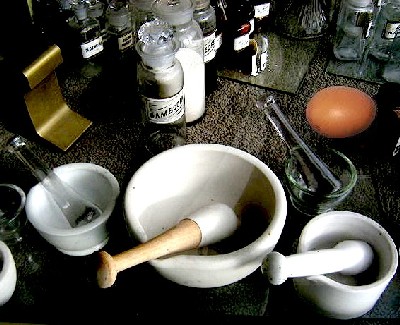
Apothecary Tools
Sea physician William Cockburn notes that when purging medicines have been used, doctors may have recourse to astringent medicines, which then work "either by thickening the Mass of Liquors in general; whereby their Discharge comes to be of a less Quantity: Or else, by affecting the Discharging Liquor, at its Canals, and Place of Discharge, as to become some Bar and Hindrance so its Flowing out of them"1. He guardedly admits that "they are not without their use"2.
Sea surgeon John Atkins' suggests something quite different when trying to stop a gonorrheal discharge. "I have compass'd [attempted to dry up the running] sometimes (in Athletick Constitutions) by a single quick Purge; which shows, that a Cathartick [purgative], without any other Property than its stimulating Power increas'd, will turn Astringent, and dry up the Liquor of the Glands"3. Here, the medicines he suggests appear to have both a purging and binding property. He then lists "some of those Preparations I've most successfully experienced" which includes a variety of purging medicines already discussed. Of the ten compound recipes he provides here, the top two both contain Sal Prunellæ (Crystal Mineral), Balsamum Capivi (Balsam of Capivi) and powdered Rhubarb, among other ingredients.
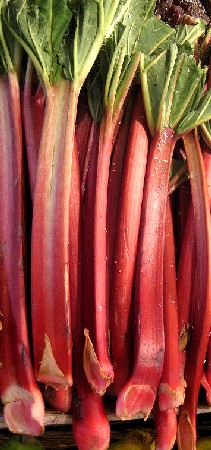
Photo: Foodista - Rhubarb Stalks
Both Atkins and Cockburn find problems with astringent medicines. Atkins says that when astringent medicines are used 'unseasonably' (meaning too quickly, not allowing the urethral discharge to flow long enough), the gonorrheal poison will "revert and taint the whole Mass of Blood, or produce by a nearer Translation acute Pain, Tumour, and Inflammation of the Groin or Testicles"4.
Cockburn gives a longer explanation, again suggesting that the astringents "could not have been useful, if the Matter of the Gonorrhœa had proceeded out of the Prostatæ"5 and, as Atkins noted, will eventually drive the poison into the bloodstream. He elsewhere notes that "It happens very commonly, in most of the great Evacuations, that the Cause of them is often augmented, and seldom changed, by Restringent Medicines... for their succeeding in a wrong time, often produces Worse Diseases, than those we should cure"6. Here he agrees with Atkins. Cockburn also complains that even when astringents work, "it is only for so long a time as the Excretory Ducts can contain it: Which afterwards bursts out, in so surprising a Quantity, as often exceeds the greatest we see in any one Day of a Gonorrhœa"7.
Of course, it wouldn't be a proper Cockburn description if he didn't backtrack a bit. He says astringents do have a place in treating gonorrhoea, "which is the Stopping an Exorbitant Effusion of any Liquor."8 He goes on to explain that "Astringent Medicines are of great Use: For the Relaxation of the Excretory Ducts may be preserved, as well as restored by them: And the Circumstances of Blood, already mentioned, may be changed, so as the great Quantity of Running may be moderated"9. Like Atkins, he hints that Astringents are best when used properly and at the right time. He notes that "the Difference of a Partial, or Total, Stoppage [of urethral discharge in a gonorrhea] is so considerable; that Misfortunes of the former are twenty times more easily retrieved than those of the last."10 He then provides a list of seventeen astringent concoctions "which are chiefly depended on, in the Practice of a Gonorrhœa."11
In addition to the previously mentioned four astringents, several others are included in the prescriptions included by Cockburn and Atkins for treating gonorrhea. Among the other astringent medicines found in the Sea Surgeon's Dispensatory are: Aqua Plantaginis (Plantane Water), Baceæ Juniperi (Juniper Berries), Bolus Armenus (Armenian Bole), Cinamoni (Cinnamon), Corallium Rubrum (Red Coral), Flores Rosarum Rubrarum (Red Roses),
Photo: Museum de Universitat MUT
An Example of a Tertiary Syphilitic Gumma of the Nose
Mastic, Mummia (Mummy), Myrrha (Myrrh), Pulvis Sanguis Draconis (Powdered Dragon's Blood) & Sanguis Draconis (Dragon's Blood Resin), Saccharum Saturni (Sugar of Lead), Terra Sigilata (Sealed Earth, Earth of Lemnos), Terebinthina Venetiæ (Venice Turpentine) & Vitriolum (Blue Vitriol).12
Astringents are also used in treating a couple of symptoms associated with syphilis. Sea surgeon John Moyle says that for sores which appear in conjunction with the pox, a medicine which is "purging and astringing, consummates this Cure."13 Cockburn similarly advises that when treating Gummas - soft 'gummy' growths that appear in the last stage of syphilis - "the Applications [used]... may carry some degree of Astringence with them". He adds that once "no further Apprehensions remain from the Bruised Part, the former Medicines may be made more astringent, with some Roman Vitriol [vitriolum or blue vitriol] dissolved in them, or some Aq. Opthalmica Sapphirina; which will perfect the Cure"14.
1 William Cockburn, The Symptoms, Nature, Cause and Cure of a Gonorrhoea, 1713, p. 111; 2 Cockburn, p. 110; 3 John Atkins, Lues Venerea, not dated, p. 30; 4 Atkins, Lues Venerea, p. 28; 5 Cockburn, p. 112; 6 Cockburn, p. 110; 7 Cockburn, p. 109; 8,9 Cockburn, p. 111; 10 Cockburn, p. 112; 11 Cockburn, p. 113; 12 See Atkins, Lues Venerea, p. 30-1 & Cockburn, p. 113-6; 13 John Moyle, Chirugius Marinus: Or, The Sea Chirurgeon, 1693, p. 141; 14 Cockburn, p. 167-8
VD Medicines: Balsamics
Balsamic medicines (also called vulnerary medicines) are used to heal wounds and cause them to grow new flesh. Naval physician William Cockburn explained that medical writers thought the fluid being ejected from the urethra "had a great Resemblance to the Pus or Quittor of a Sore, if it was not altogether the very same Substance (it is indeed pus); [and so they] adminstred inwardly
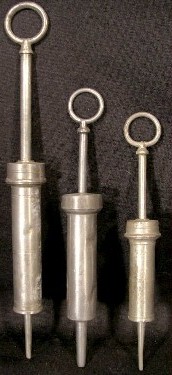
Photo: Mission
Small 18th c. Style Pewter Syringes
From the Author's Collection
the safest... Balsams, they had experienced in outward applications"1. What he means by 'administred inwardly' is not entirely clear here. Fortunately, another author explains this in detail.
Sea surgeon John Woodall mentions using such a vulnerary lotion for similar reasons, "most commonly it is all in all to be used as an injection generally for griefes of the yard [penis], as well within the passage as also twixt glans [head of the penis] and preputium [foreskin], and in Gonorrhea, excoriations [tissue damage] thereof, and strengthneth well the parts, and ...you use it within the passage of the yard"2. Woodall goes on to advise that when balsam injections are used, they are "be very gently done" and never "within the passage of Virga [the urethra] cold, but warme ever"3. Here, Woodall uses vulnerary lotions to heal.
Cockburn naturally says that balsams do not work when treating a gonorrhea. He notes that even when balsams are applied in such cases, "the Matter of the Gonorrhoea does not become Softer and Smoother; however it becomes whiter. On the contrary, it is thicker and more tenacious, very much differing from what we see, when Balsamical Medicines are outwardly apply'd."4 He goes on to state that the medicine's healing properties do not function properly in this case, although they do stop the urethral discharge, which he says makes them work like astringents.
Sea surgeon John Atkins uses balsamics for a different purpose when treating gonorrhea, suggesting that there are two situations during treatment where healing medicines are required. The first is when the urethral discharge has been prematurely stopped either by the improper use of purges or astringent medicines. Atkins says this results in the discharge flowing back into
Photo: Valentina Vivod - Balsam of Peru
the body, tainting the blood or resulting in "Pain, Tumour, and Inflammation of the Groin or Testicles... particularly in the last [when] the Pains are agonizing, and attended with Fever, Syncope [loss of consciousness] and Nausea"5. The second situation requiring balsamics is when "there
is too cautious and long an adherence to Mercurials, or irritating Medicines, whether Catharticks [purges] or Diureticks, [and] the Running goes on without end"6. Atkins does not agree with Cockburn that balsams fail to function here, nor does he suggest that they work like astringents, instead stating that they solve the problems created by such medicines.
A variety of balsamic medicines are mentioned for treatment of venereal diseases, particularly gonorrhea. Woodall prescribes "vulnerary hearbs in their prime gathered and decocted with Alluminis [alum] and mell [honey] in aqua pura [pure water]"7. Unfortunately, he doesn't specify the herbs. Neither alum nor honey were thought to be balsamic in nature.
Although he dismisses their use, Cockburn naturally mentions a number of medicines he says are useful since "their Effects in stopping a Gonorrhœa, the Manner of doing it, and the like Relapses, are perfectly the same with Astringent Medicines"8. His vulnerary medicines include Turpentine, "Balm of Gilead, Balsam Capyvi, or natural Balsam (of Peru) with proper Waters."9
1 William Cockburn, The Symptoms, Nature, Cause and Cure of a Gonorrhoea, 1713, p. 117; 2,3 John Woodall, the surgions mate, 1617, p. 62; 4 Cockburn, p. 118; 5 John Atkins, Lues Venerea, not dated, p. 28; 6 Atkins, p. 28-9; 7 Woodall, p. 62; 8 Cockburn, p. 119; 9 Cockburn, p. 120

